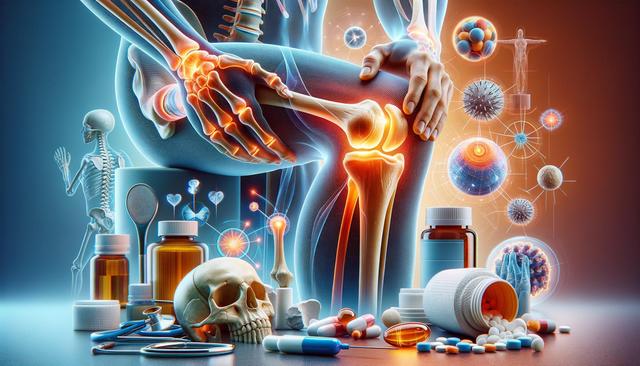Understanding Osteoarthritis and Its Impact
Osteoarthritis is a chronic joint condition that results from the breakdown of cartilage, leading to pain, stiffness, and reduced mobility. It commonly affects weight-bearing joints such as the knees, hips, and spine, though it can impact any joint in the body. As the most prevalent form of arthritis, osteoarthritis can significantly affect daily activities, particularly in older adults. For those looking into how to manage joint pain from arthritis, it is important to recognize the signs early and seek appropriate medical advice. Early intervention can help slow down the progression and reduce discomfort.
The condition is often caused by a combination of factors including age, joint injury, obesity, and genetics. Symptoms may develop gradually and worsen over time, making it essential to monitor joint health consistently. Regular check-ups and imaging tests can help identify the extent of joint damage and guide treatment decisions. Education about the condition can empower individuals to adopt a proactive approach to managing their joint health.
Medical and Lifestyle Treatments for Osteoarthritis Pain
There are several medical and lifestyle options available to help ease the symptoms of osteoarthritis. Treatments for osteoarthritis pain typically begin with non-invasive approaches and may be adjusted based on the severity of the condition. Pain-relieving medications such as acetaminophen or nonsteroidal anti-inflammatory drugs (NSAIDs) are commonly recommended by healthcare providers. In some cases, corticosteroid injections may be used to reduce inflammation and discomfort in affected joints.
In addition to medications, lifestyle modifications play a critical role. These include:
- Maintaining a healthy weight to reduce stress on joints
- Engaging in low-impact exercises like swimming or walking
- Using supportive footwear or braces for joint stability
- Participating in guided physical therapy
These adjustments not only alleviate pain but also help improve mobility with arthritis care. Combining these strategies with regular monitoring can lead to better long-term outcomes.
Non Surgical Options for Osteoarthritis
For many individuals, non surgical options for osteoarthritis can provide significant relief without the risks associated with invasive procedures. Physical therapy remains one of the most effective non-surgical treatments, as it strengthens the muscles around the joints and enhances flexibility. Occupational therapy can also assist individuals in modifying daily tasks to reduce joint strain.
Assistive devices such as canes, walkers, or ergonomic tools can make daily activities easier and safer. Additionally, alternative therapies like acupuncture or massage therapy are gaining recognition for their potential to reduce pain and improve function. Although the effectiveness of these therapies may vary from person to person, they serve as valuable additions to a comprehensive treatment plan.
It is also worth discussing hyaluronic acid injections or platelet-rich plasma (PRP) therapy with a healthcare provider. These treatments aim to lubricate the joints or promote tissue repair, providing another layer of non-surgical support for managing osteoarthritis.
Exploring Natural Remedies for Osteoarthritis Relief
In recent years, many people have turned to natural remedies for osteoarthritis relief to complement traditional medical treatments. These remedies often focus on reducing inflammation and supporting joint health through dietary and supplemental means. Some commonly used natural options include:
- Omega-3 fatty acids found in fish oil
- Turmeric, known for its anti-inflammatory properties
- Glucosamine and chondroitin supplements
- Ginger, which may help reduce joint swelling
Incorporating anti-inflammatory foods such as leafy greens, berries, and nuts into your diet can also contribute to joint comfort. Staying hydrated and avoiding processed foods may further support joint function and overall health. While these remedies are generally safe, it is important to consult with a healthcare professional before starting any new supplement, especially for those taking other medications.
Many individuals find that a holistic approach, combining natural remedies with conventional treatments, offers the most effective relief. This approach can support the body’s natural healing processes and promote a more active lifestyle.
Improving Mobility and Quality of Life
Dealing with osteoarthritis is not just about managing pain—it’s also about enhancing mobility and maintaining independence. To improve mobility with arthritis care, a well-rounded strategy that includes physical activity, joint protection, and therapeutic interventions is essential. Strength training and range-of-motion exercises are especially beneficial in maintaining joint flexibility and muscle support.
Regular movement, even in small amounts, helps prevent stiffness and improves circulation. Setting realistic goals and celebrating progress can boost motivation and emotional well-being. Support groups or community-based programs can also provide encouragement and share practical tips for daily living with arthritis.
Working closely with healthcare providers, including rheumatologists, physical therapists, and dietitians, can lead to a personalized care plan that meets individual needs. By taking active steps toward managing the condition, individuals can continue to enjoy activities they love and maintain a fulfilling lifestyle despite the challenges of osteoarthritis.
Conclusion: Taking a Comprehensive Approach to Osteoarthritis Care
Osteoarthritis can be a life-altering condition, but with the right combination of medical treatments, lifestyle changes, and supportive care, individuals can effectively manage symptoms and maintain mobility. Whether exploring treatments for osteoarthritis pain, seeking non surgical options for osteoarthritis, or trying natural remedies for osteoarthritis relief, a multi-faceted approach offers the best chance for ongoing comfort and function. By staying informed and proactive, those living with osteoarthritis can improve their quality of life and continue to participate in meaningful daily activities.




Leave a Reply